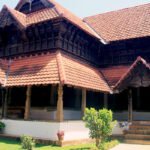The history of tamil nadu vellore fort
Vellore fort :
Vellore Fort, located in the town of Vellore in Tamil Nadu, India, stands as a prominent symbol of South Indian history. With its massive stone walls, intricate design, and rich cultural significance, the fort is a reminder of the region’s architectural splendor and historical importance. Its evolution is deeply tied to the various dynasties that ruled Tamil Nadu over the centuries. This article explores the history of Vellore Fort, focusing on its construction, architecture, cultural relevance, and significance in local history, without delving deeply into political events.
Early History and Construction
The history of Vellore Fort dates back to the 16th century, during the reign of the Vijayanagar Empire. Originally, the site may have been used for military purposes, as the strategic location of the fort at the confluence of the Palar River and a smaller stream made it an ideal defense point. However, the fort as it stands today was constructed by the Vijayanagar Empire in the late 16th century, around 1566, during the reign of the emperor Sriranga Deva Raya II. The fort was built to defend the kingdom from external threats, particularly from the Sultanates in the Deccan.
Though the construction of the fort is often attributed to the Vijayanagara Empire, its current form and features are primarily the result of modifications made by the later rulers, particularly the Marathas and the British. The fort’s walls are made of granite and stretch to about 1.5 kilometers in circumference. This fort was designed not just as a military bastion but also to serve as a seat of power, housing various structures for governance and defense.
Architecture and Features of the Fort
Vellore Fort’s architecture is a blend of South Indian and Islamic styles, reflecting the different rulers who modified and expanded it over time. The fort is an excellent example of the military architecture of the region, with its massive stone walls, wide moats, and watchtowers, designed to withstand prolonged sieges.
1. Entrance and Outer Walls: The fort has a grand entrance on the western side, with a wide moat surrounding it. The fort’s perimeter is marked by imposing walls made of large granite blocks, which not only served as a defense mechanism but also showcased the engineering skills of the period.
2. Moat and Water System: One of the fort’s unique features is its moat. Unlike many other forts which had dry walls, the Vellore Fort’s moat was designed to be filled with water, making it harder for attackers to approach the walls. The presence of the moat suggests the importance of water management in the fort’s design, especially given the region’s hot and dry climate.
3. Fortifications and Watchtowers: The fort’s fortifications are sturdy, with square watchtowers placed at regular intervals. These towers allowed for surveillance of the surrounding area, and they were used as lookout points during potential conflicts. The high walls also offered protection against attackers, and the raised position of the fort made it a strategic point for observing the surrounding plains.
4. The Jalakandeswarar Temple: Inside the fort, one of the most significant structures is the Jalakandeswarar Temple, dedicated to Lord Shiva. Built by the Vijayanagara kings, this temple is an excellent example of the Vijayanagara style of architecture, with its intricate carvings and large, ornate hall. The temple is famous for its beautifully sculpted pillars and the stone carvings that depict various gods, goddesses, and mythological creatures. The temple also features a unique water tank, known as the “Jalakandeswarar tank,” which is believed to have been used for religious purposes.
5. Other Structures: The fort also houses several other buildings, including a palace for the rulers and barracks for soldiers. These structures were later modified and expanded under the Marathas and the British, who added their own architectural elements to the fort. However, the original Vijayanagara features are still visible, especially in the temple complex.
Cultural Significance
Vellore Fort’s cultural significance is multi-faceted. It is not only a military and architectural marvel but also a place of deep cultural and religious importance. The fort is home to the Jalakandeswarar Temple, which has been a site of worship for centuries. The temple’s architectural beauty and the religious practices associated with it contribute to the fort’s cultural value.
Additionally, the fort has played an essential role in local folklore and tradition. Many generations of local people have interacted with the fort, whether as a place of refuge, a site for religious ceremonies, or as a symbol of local pride. The presence of numerous inscriptions within the fort, as well as the stories of historical events associated with it, help preserve the cultural fabric of the region.
The fort’s influence extends beyond the local community, as it serves as a significant cultural and heritage landmark in Tamil Nadu. Over time, it has become a symbol of the historical richness of the region, attracting scholars, historians, and tourists interested in understanding the architectural styles and cultural history of the area.
The Role of the Marathas and the British
In the 17th century, the fort came under the control of the Marathas. The Marathas made several modifications to the fort, reinforcing its military capabilities. The fort’s stronghold was used as a base for military operations in the region. However, in the 18th century, the fort was captured by the British during their colonial expansion.
Under British control, the fort continued to be used as a military station. The British added certain military structures to the fort, but much of its original design was retained. They also utilized the fort for administrative purposes, which added a layer of governance to its existing functions.
Despite these political shifts, the fort remained a center of local culture and religious significance. The Jalakandeswarar Temple, for instance, continued to draw pilgrims even during British rule, though certain religious practices were modified during this period.
The Fort in Modern Times
Today, Vellore Fort stands as a popular historical and tourist attraction. The fort, managed by the Archaeological Survey of India (ASI), has been well-preserved, and efforts have been made to maintain its structural integrity. The fort is an important destination for those wishing to understand the architectural and cultural heritage of South India.
The fort attracts visitors from around the world, not just for its military significance but also for its rich history, its connection to the cultural practices of Tamil Nadu, and the serene beauty of its temple complex. The fort also serves as a reminder of the dynamic historical landscape of the region, where various dynasties, empires, and cultures have left their imprint
The history of Vellore Fort is a story of architectural grandeur, cultural richness, and historical transformation. From its construction under the Vijayanagara Empire to its role in the local religious and cultural life, Vellore Fort represents a synthesis of military defense and architectural beauty. The fort has witnessed the passage of time, with the influences of various dynasties leaving their mark on its design and purpose.
Today, Vellore Fort stands as a living monument to the region’s history, offering insights into the architectural ingenuity, cultural practices, and military strategies of the past. Its preservation ensures that future generations will continue to learn from and appreciate the historical significance of this enduring landmark. Through its walls, temples, and inscriptions, Vellore Fort remains a testament to the rich and diverse cultural heritage of Tamil Nadu.









